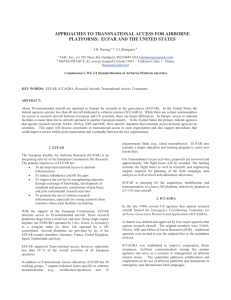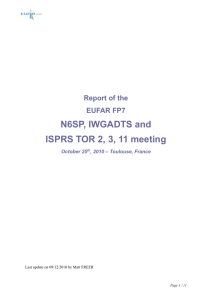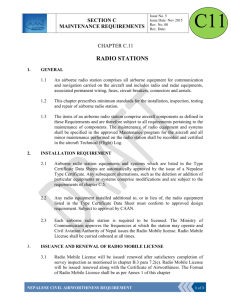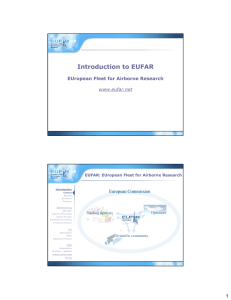eufar - CORDIS
advertisement
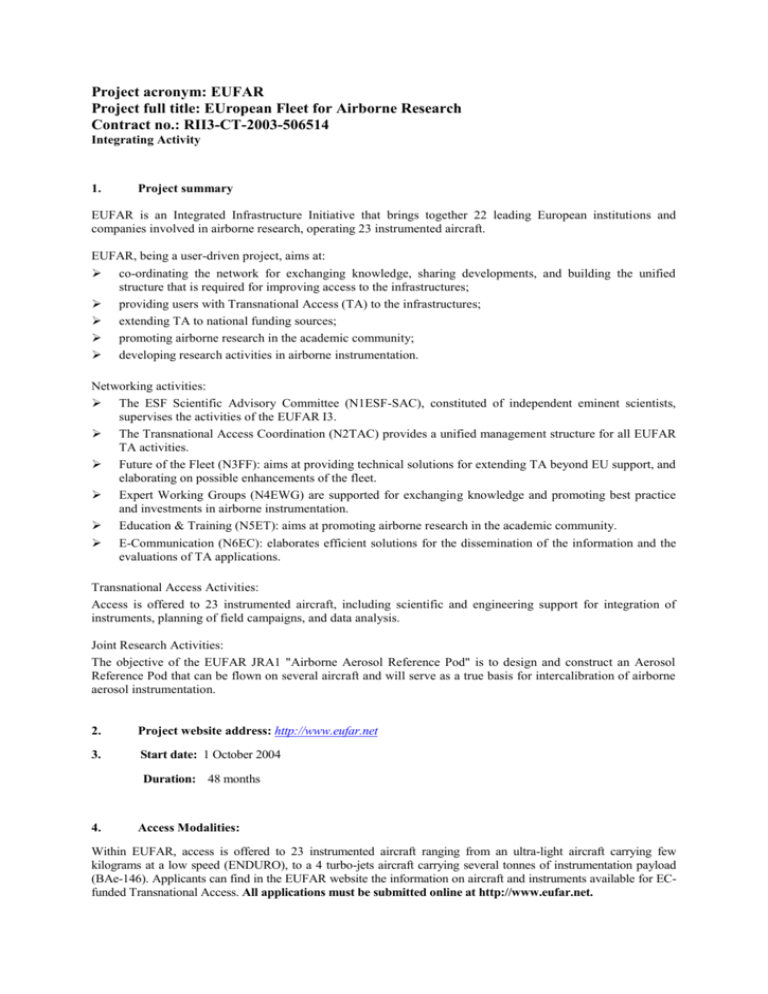
Project acronym: EUFAR Project full title: EUropean Fleet for Airborne Research Contract no.: RII3-CT-2003-506514 Integrating Activity 1. Project summary EUFAR is an Integrated Infrastructure Initiative that brings together 22 leading European institutions and companies involved in airborne research, operating 23 instrumented aircraft. EUFAR, being a user-driven project, aims at: co-ordinating the network for exchanging knowledge, sharing developments, and building the unified structure that is required for improving access to the infrastructures; providing users with Transnational Access (TA) to the infrastructures; extending TA to national funding sources; promoting airborne research in the academic community; developing research activities in airborne instrumentation. Networking activities: The ESF Scientific Advisory Committee (N1ESF-SAC), constituted of independent eminent scientists, supervises the activities of the EUFAR I3. The Transnational Access Coordination (N2TAC) provides a unified management structure for all EUFAR TA activities. Future of the Fleet (N3FF): aims at providing technical solutions for extending TA beyond EU support, and elaborating on possible enhancements of the fleet. Expert Working Groups (N4EWG) are supported for exchanging knowledge and promoting best practice and investments in airborne instrumentation. Education & Training (N5ET): aims at promoting airborne research in the academic community. E-Communication (N6EC): elaborates efficient solutions for the dissemination of the information and the evaluations of TA applications. Transnational Access Activities: Access is offered to 23 instrumented aircraft, including scientific and engineering support for integration of instruments, planning of field campaigns, and data analysis. Joint Research Activities: The objective of the EUFAR JRA1 "Airborne Aerosol Reference Pod" is to design and construct an Aerosol Reference Pod that can be flown on several aircraft and will serve as a true basis for intercalibration of airborne aerosol instrumentation. 2. Project website address: http://www.eufar.net 3. Start date: 1 October 2004 Duration: 48 months 4. Access Modalities: Within EUFAR, access is offered to 23 instrumented aircraft ranging from an ultra-light aircraft carrying few kilograms at a low speed (ENDURO), to a 4 turbo-jets aircraft carrying several tonnes of instrumentation payload (BAe-146). Applicants can find in the EUFAR website the information on aircraft and instruments available for ECfunded Transnational Access. All applications must be submitted online at http://www.eufar.net. There are 2 levels for applying: Master and PhD students can apply through the Education and Training activity Experienced researchers must apply through the “regular” Transnational Access activity Applicants must come from a different country than the one where the requested research infrastructure is located. Priority will be given to new users. 5. Project Achievements: The long term structuring effect of the EUFAR I3, involving most of the European research aircraft operators, will be first measurable by the evolution of the culture of cooperation between European aircraft operators The User Group Selection Panel will further contribute to the European integration. On a longer term, multi-lateral agreements between European countries will definitely consolidate the network of research aircraft by actively integrating countries, which do not presently operate instrumented aircraft. With the ESF-SAC, EUFAR has constituted the necessary link between the network of operators and the NRFIs (National Research Funding Institutions), for providing them with guidance on the feasibility of such agreements. The “Airborne Aerosol Reference Pod” JRA, leading to the development of shared measurement or calibration systems, will reinforce the culture of cooperation among operators and instrument developers at the European level. Perspective for long term sustainability of these achievements also relies on the development of efficient and common management tools, mainly based on E-Communication, that are among the priorities of the Networking Activities in EUFAR. Within N6EC, solutions will be explored regarding the difficulties for operators to update the planning of occupation of the EUFAR fleet with information related to their national activities. Solutions will be proposed to interface each specific operator’s management application with the common EUFAR workflow. It is expected that roughly 30% of the new users of research aircraft will remain in close contact with the operator and/or their nationally funded science groups. The expected effect of widening the customer base and the topic areas for the research aircraft will bring about a greater integration of the operators and produce a larger, more active, user community. The European scientific community will thus benefit from a better characterised and understood instrument base, yielding better quality data more effectively. In the longer term, the confidence gained through this process will enable national interests and biases to be put to aside and for the fleet of aircraft to be developed in response to the European needs. 6. List of participants of the I3 Participant number Organisation Participant (name, city, country) short name 1 Météo-France, Toulouse, France Météo-France 2 Fondation Européenne de la Science, Strasbourg, France ESF 3 Democritus University of Thrace, Xanthi, Greece DUTH 4 Deutsches Zentrum für Luft- und Raumfahrt e.V., Köln, Germany DLR 5 Stichting Nationaal Lucht- en Ruimtevaartlaboratorium, Amsterdam, The Netherlands NLR 6 enviscope GmbH, Frankfurt/Main, Germany Enviscope Institut National des Sciences de l’Univers 7 Centre National de la Recherche Scientifique, Paris, France INSU-CNRS 8 Met Office, Exeter, United Kingdom MetOffice 9 Natural Environment Research Council, Swindon, United Kingdom NERC (ARSF/BGS) 10 Instituto Nacional de Técnica Aeroespacial, Madrid, Spain INTA 11 Tel Aviv University, Tel Aviv, Israel TAU 12 Geologian tutkimuskeskus (Geological Survey of Finland), Espoo, Finland GTK 13 Institute of Flight Guidance and Control, Technical University Braunschweig, Braunschweig, Germany TU-BS 14 Freie Universität Berlin, Berlin; Germany FUB 15 MetAir AG – airborne measurements and consulting, Hausen am Albis, Switzerland METAIR 16 CNR – Istituto Sistemi Agricoli e Forestali Mediterranei, Ercolano, Italy CNR-ISAFoM 17 Forschungszentrum Karlsruhe GmbH, Karlsruhe, Germany FZK 18 Stockholms Universitet, Stockholm, Sweden MISU 19 Max-Planck-Society for the advancement of the science represented by Max-Planck-Institute for Chemistry, Mainz, Germany MPI-C 20 National University of Ireland, Galway, Ireland NUIG 21 University of Manchester Institute of Science and Technology, Manchester, United Kingdom UMIST 22 Leibniz-Institut für Troposphärenforschung, Leipzig, Germany IFT
